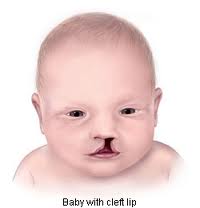Cleft Lip – Keep it Clean
By Jill Feilmeier on January 24, 2013 in Kid's Health

Each year 2,651 babies in the United States are born with a cleft palate and 4,437 babies are born with a cleft lip with or without a cleft palate1. While the exact cause is unknown, there are steps you can take before and during your pregnancy to reduce your child's risk.
– Don't smoke. There is evidence suggesting that smoking can cause a cleft lip and/or cleft palate.
– Eat healthy before, and during your pregnancy. While eating badly has not been linked to the occurrence of a cleft lip, pre-pregnancy diabetes has been shown to increase the risk.
If your child is born with a cleft lip or palate, they require meticulous oral health care including proper cleaning of the teeth with a baby sized, soft-bristle toothbrush or soft, damp washcloth. Brushing should begin as soon as a tooth erupts.
With a cleft lip and/or palate, the teeth can rotate out of position, be missing or there can be extra teeth. This makes brushing more difficult. The persisting soft tissue folds make it a challenge to keep the teeth and gums clean. This challenge only makes a good oral health routine even more vital.
Children with a cleft are also vulnerable to tooth decay. Fluoride gels or fluoride varnish application and drinking fluoridated water strengthen tooth enamel. Partaking in these preventative actions will help reduce your child's risk of tooth decay.
Cleft surgery is more effective when optimal dental health of the teeth and gums is maintained.
So, start early. Supplement routine daily home care with frequent and regular visits to a dentist who will supervise dental care as part of a team of professionals.
– Written by Dr. Michael Okuji, Dental Director
1. http://www.cdc.gov/ncbddd/birthdefects/cleftlip.html